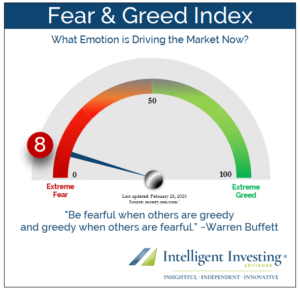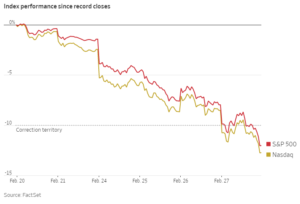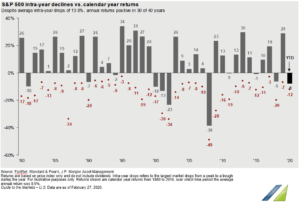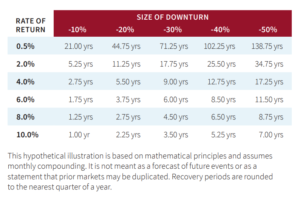Reading Time: 4 minutes
We have recently seen an uptick in volatility and fear. As you can see from this Fear & Greed Index, which represents what emotion is driving the market now, there has been an increase in fear.

U.S. stocks extended a punishing selloff, finishing their worst week since the financial crisis, after entering into correction territory this week. Investors braced for the coronavirus to slow business activity and depress earnings. The Dow industrials, Nasdaq and S&P 500 closed down more than 10% from recent highs. But it was nowhere close to the destruction on Black Monday in 1987 or the financial crisis of 2008. Still, for investors lulled to sleep by the steady upward climb since the beginning of 2019, it was a wake-up call. Even Federal Reserve Chairman Jerome Powell signaled the central bank was prepared to cut interest rates if needed. With markets in the longest bull market in history, a pullback or correction almost seems foreign.
Be fearful when others are greedy and greedy when others are fearful. ~Warren Buffett Share on X
What is a Correction?
A correction is a decline or downward movement of a stock, a bond, a commodity or market index. The amount of the decline is at least 10 percent but not more than 20 percent. In short, corrections are price declines that stop an upward trend.
Irrational Behavior
When the stock market starts tumbling — especially when it’s down more than 10% — many people panic and start to sell. They’re scared the slide could turn into a death spiral. Maybe they are being prudent and sensible. No, often, they are being irrational.
If you panic and move into cash during a correction, you may well be doing so right before the market rebounds. Once you understand that the vast majority of corrections aren’t that bad, it’s easier to keep calm and resist the temptation to hit the eject button at the first sign of turbulence.
Inhale, Exhale
Let’s all take a deep breath. As many commentators have noted, this market was overdue a correction, which is much healthier than continued parabolic increases in share prices.
A stock market correction isn’t necessarily a bad thing depending on the context you view the correction from. However, there are five important things you really should know about a stock market correction.
1. Stock market corrections happen often
The first thing you should know is that stock market corrections happen fairly often. The U.S. economy naturally peaks and troughs over time, and in response, the stock market will also have its peaks and troughs. On average, there’s been a market correction every year since 1900.
On average, there’s been a market correction every year since 1900. Share on XLong story short, corrections are an inevitable part of stock ownership, and there’s nothing you can do as an individual investor to stop a correction from occurring.
2. Stock market corrections rarely last long
Corrections last for a shorter period of time than bull markets. Stock market corrections often tend to be on the order of a few weeks to two quarters in length.
3. Stock market corrections shouldn’t matter if you’re a long-term investor
If you remain focused on the long-term with retirement as your goal, then you’ll realize that stock market corrections really aren’t an issue The only people who should be worried when corrections roll around are those who’ve geared their trading around the short-term or those who’ve heavily leveraged their account with the use of margin. Maintaining a long-term perspective has been the smartest way to invest throughout history – and it also happens to be a recipe for a good night’s sleep.
4. They’re also a good reminder to reassess and rebalance
It’s important that you reassess your holdings to ensure that the thesis of your purchase remains intact. Ask yourself one simple question with each stock in your portfolio: Is the reason I bought this stock still valid today? If the answer is “yes,” then no action is required, other than perhaps adding to your position.
Rebalancing is another way to reduce risk in your portfolio. By rebalancing back to pre-determined portfolio weights, the risk may be reduced, allowing you greater chances of achieving your goals.

Moving assets into conservative investments with low rates of return, such as Treasury bills or cash, may prolong the time it takes for your account to recover from a downturn. Remember, the greater the bear market decline, the longer the recovery time.

5. Nobody can predict the future.
Unfortunately, no economist or advisor knows exactly what the future holds. I repeat…no human knows what the future holds. It is important to have a long time horizon and accountability advisor who can be your behavioral coach, especially as market volatility may likely increase. At Intelligent Investing, we strive to align our clients’ portfolio with their financial plan and goals, keeping in mind their ability to take on risk and their willingness to take on risk.
What can I do or what should I do?
Coronavirus concerns are causing some investors to panic, but Intelligent Investing sees no reason to alter or deviate from your investment strategy or broader financial plan. That’s why it’s important to stay invested and stay focused on your long-term goals. As an intelligent investor, you need to do only three things:
- Diversify,
- Rebalance, and
- Maintain a long-term focus.
The above three things are harder to due during times of market volatility. At Intelligent Investing, we’re here to help, so visit our story or behavioral coaching page to learn more about how we protect your investments during these uneasy times. As risk managers, we monitor portfolios and are alerted when portfolios breach a predetermined risk tolerance band. If you’d like to learn more about how we may help you manage your wealth to achieve your goals, please click here. We look forward to the opportunity of serving you soon.
Further Reading and Resources
- Time in Markets is Important, Not Timing Markets
- How the Coronavirus May Affect the Stock Market
- How Diversification is like taking a U.S. Road Trip
Understanding Market Downturns
[gview file=”https://investedwithyou.com/wp-content/uploads/2020/02/Understanding-Market-Downturns.pdf”]Bonus: Here are the past 12 corrections in the S&P 500 index.
| Span of the correction | Percent Decline |
| Jan. 26, 2018-Feb. 8, 2018 | 10.2% |
| May 21, 2015-Feb. 11, 2016 | 14.2% |
| April 29, 2011-Oct. 3, 2011 | 19.4% |
| April 23, 2010-July 2, 2010 | 16.0% |
| Nov. 27, 2002-March 11, 2003 | 14.7% |
| July 16, 1999-Oct. 15, 1999 | 12.1% |
| July 17, 1998-Aug. 31, 1998 | 19.3% |
| Oct. 7, 1997-Oct. 27, 1997 | 10.8% |
| Oct. 9, 1989-Jan. 20, 1990 | 10.2% |
| Oct. 10, 1983-July 24, 1984 | 14.4% |
| Feb. 13, 1980-March 27, 1980 | 17.1% |
| Oct. 5, 1979-Nov. 7, 1979 | 10.2% |
Source: S&P Dow Jones Indices, FactSet

